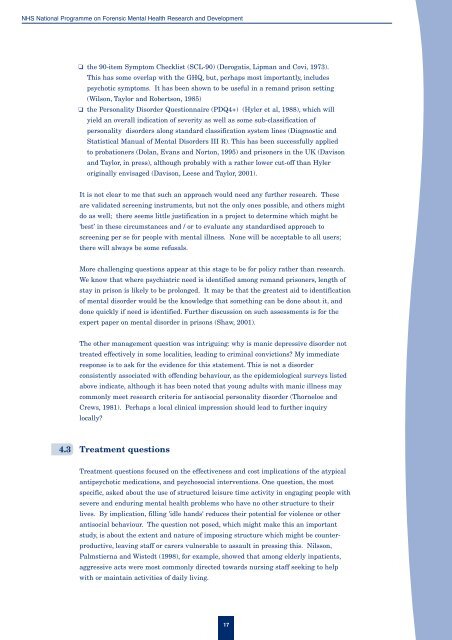Mental Illness and Serious Harm to Others - University of Liverpool
Mental Illness and Serious Harm to Others - University of Liverpool
Mental Illness and Serious Harm to Others - University of Liverpool
Create successful ePaper yourself
Turn your PDF publications into a flip-book with our unique Google optimized e-Paper software.
NHS National Programme on Forensic <strong>Mental</strong> Health Research <strong>and</strong> Development<br />
❑ the 90-item Symp<strong>to</strong>m Checklist (SCL-90) (Derogatis, Lipman <strong>and</strong> Covi, 1973).<br />
This has some overlap with the GHQ, but, perhaps most importantly, includes<br />
psychotic symp<strong>to</strong>ms. It has been shown <strong>to</strong> be useful in a rem<strong>and</strong> prison setting<br />
(Wilson, Taylor <strong>and</strong> Robertson, 1985)<br />
❑ the Personality Disorder Questionnaire (PDQ4+) (Hyler et al, 1988), which will<br />
yield an overall indication <strong>of</strong> severity as well as some sub-classification <strong>of</strong><br />
personality disorders along st<strong>and</strong>ard classification system lines (Diagnostic <strong>and</strong><br />
Statistical Manual <strong>of</strong> <strong>Mental</strong> Disorders III R). This has been successfully applied<br />
<strong>to</strong> probationers (Dolan, Evans <strong>and</strong> Nor<strong>to</strong>n, 1995) <strong>and</strong> prisoners in the UK (Davison<br />
<strong>and</strong> Taylor, in press), although probably with a rather lower cut-<strong>of</strong>f than Hyler<br />
originally envisaged (Davison, Leese <strong>and</strong> Taylor, 2001).<br />
It is not clear <strong>to</strong> me that such an approach would need any further research. These<br />
are validated screening instruments, but not the only ones possible, <strong>and</strong> others might<br />
do as well; there seems little justification in a project <strong>to</strong> determine which might be<br />
'best’ in these circumstances <strong>and</strong> / or <strong>to</strong> evaluate any st<strong>and</strong>ardised approach <strong>to</strong><br />
screening per se for people with mental illness. None will be acceptable <strong>to</strong> all users;<br />
there will always be some refusals.<br />
More challenging questions appear at this stage <strong>to</strong> be for policy rather than research.<br />
We know that where psychiatric need is identified among rem<strong>and</strong> prisoners, length <strong>of</strong><br />
stay in prison is likely <strong>to</strong> be prolonged. It may be that the greatest aid <strong>to</strong> identification<br />
<strong>of</strong> mental disorder would be the knowledge that something can be done about it, <strong>and</strong><br />
done quickly if need is identified. Further discussion on such assessments is for the<br />
expert paper on mental disorder in prisons (Shaw, 2001).<br />
The other management question was intriguing: why is manic depressive disorder not<br />
treated effectively in some localities, leading <strong>to</strong> criminal convictions? My immediate<br />
response is <strong>to</strong> ask for the evidence for this statement. This is not a disorder<br />
consistently associated with <strong>of</strong>fending behaviour, as the epidemiological surveys listed<br />
above indicate, although it has been noted that young adults with manic illness may<br />
commonly meet research criteria for antisocial personality disorder (Thorneloe <strong>and</strong><br />
Crews, 1981). Perhaps a local clinical impression should lead <strong>to</strong> further inquiry<br />
locally?<br />
4.3 Treatment questions<br />
Treatment questions focused on the effectiveness <strong>and</strong> cost implications <strong>of</strong> the atypical<br />
antipsychotic medications, <strong>and</strong> psychosocial interventions. One question, the most<br />
specific, asked about the use <strong>of</strong> structured leisure time activity in engaging people with<br />
severe <strong>and</strong> enduring mental health problems who have no other structure <strong>to</strong> their<br />
lives. By implication, filling 'idle h<strong>and</strong>s' reduces their potential for violence or other<br />
antisocial behaviour. The question not posed, which might make this an important<br />
study, is about the extent <strong>and</strong> nature <strong>of</strong> imposing structure which might be counterproductive,<br />
leaving staff or carers vulnerable <strong>to</strong> assault in pressing this. Nilsson,<br />
Palmstierna <strong>and</strong> Wistedt (1998), for example, showed that among elderly inpatients,<br />
aggressive acts were most commonly directed <strong>to</strong>wards nursing staff seeking <strong>to</strong> help<br />
with or maintain activities <strong>of</strong> daily living.<br />
17
















